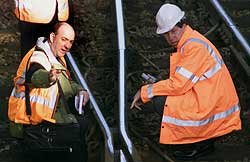 |
Nov 25th 2000
From The Economist print edition
Copyright : The Economist
Britain spends too much money, not too little, making its railways safe
|
||||
The government left no doubt that it agreed with the newspapers; and, in the five weeks since the crash, Railtrack has done its utmost to prove its concern for its customers’ safety. Rails have been ripped up all over the country, the network has descended into chaos, and the length of many journeys has doubled as the company tries to sort the problem out (see article). Yet surely it is worth all the trouble, if even one life is saved?
No, it is not. The pictures of mangled carriages are ghastly; the interviews with bereaved relatives heart-rending. But life involves risk, and calculations about how much money to spend on reducing danger have to be made in cold blood—or at least with a cool head. Governments, which invest in risk-reduction through, for instance, road-safety measures, and which legislate to require companies to spend on risk-reduction, have to ask how many lives a given amount of money can be expected to save—they must, in other words, set a price on life.
How much might that be? A worker’s probable earnings? What a mother would pay to keep her son alive? What a son would pay to keep his mother alive? There are no objective grounds for determining the price of life, so academics and civil servants have resorted to asking people how much they would pay to avoid certain risks. In Britain, this process produces a broad average price of £1m ($1.4m) per life. The figure varies little, from risk to risk. A life is a life, people reckon, however it is lost or saved.
But the government, it seems, is not as rational as the people. Although deaths on the roads vastly outnumber deaths on the railways (by 3,423 to 33 in 1999) the railways command disproportionately high spending on safety. The advanced train protection system, which is installed on some routes, would cost more than £2 billion to install nationally, implying a price on each life saved of more than £15m. The slightly more economical train warning protection system prices life at £5m. The transport department’s guidelines on road safety spending set a price of just over £1m per life. But the figure that represents the reality of investment in road safety, the one implied by local authorities’ spending on, for instance, measures to slow traffic down, or to provide pedestrians with safe places to cross roads, is a miserly £100,000 per life.
Save lives, not politicians’ faces
From the politicians’ point of view, this may be rational. Nobody notices road deaths, but each rail crash generates a frenzy of Something-Must-Be-Done editorials. So each time, in order to be seen to be doing something, the government prods the railways into extra safety spending.
It may be rational from Railtrack’s point of view, too. Even though Railtrack is a private-sector company these days, it is still a regulated monopoly, so the level of its future profits will be determined at least in part by the government. There is no reason to resist government calls for greater safety: the government will pay. So, when it prods, Railtrack jumps.
From society’s point of view, though, it is far from rational to spend 150 times as much on saving a life on the railways as on saving a life on the roads. A bereaved mother cares little how her child was killed. Many more lives could be saved if the money currently being poured into avoiding spectacular but rare railway crashes were spent instead on avoiding the tragedies that happen ten times every day on the roads.
Back to Tallrite's Response
![]()